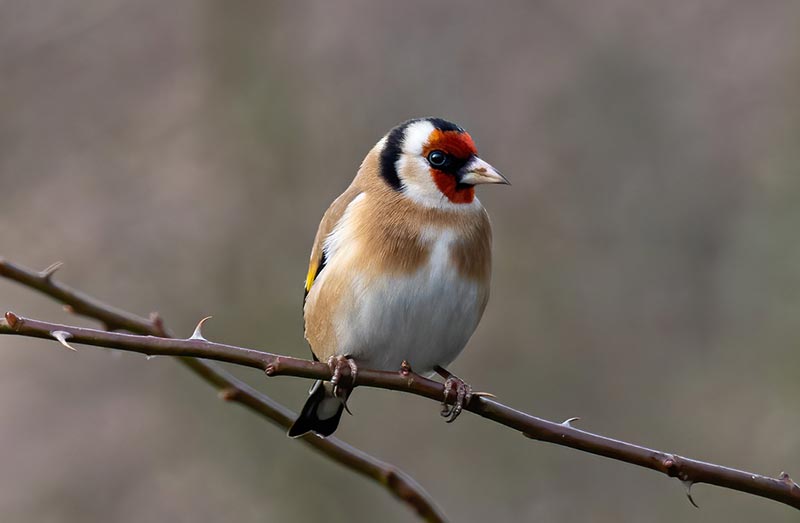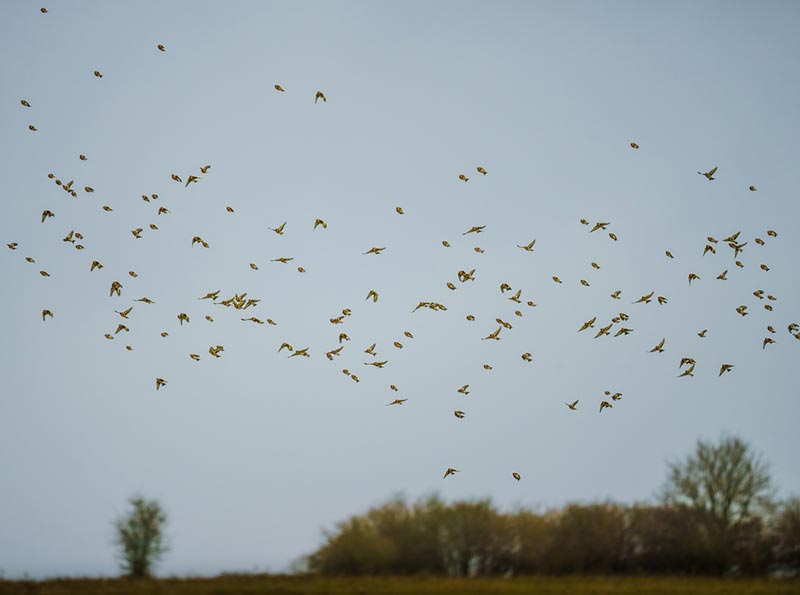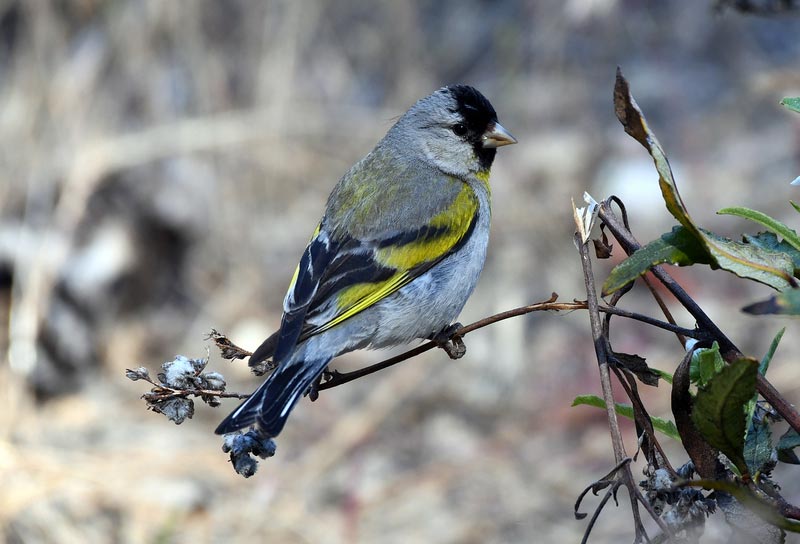Do Goldfinches Migrate? Seasons & Patterns
Last Updated on

Three species of goldfinches¹ are native to North America:
- The American Goldfinch (Spinus tristis)
- Lawrence’s Goldfinch (Spinus lawrencei)
- The Lesser Goldfinch (Spinus psaltria)
All three migrate but to varying degrees. The natural history of each one differs based on its behavior and environmental conditions. Nevertheless, all three are protected by the Migratory Bird Treaty Act of 1918¹. Understanding how migration works and the factors driving it can help you understand why these goldfinches behave differently regarding this annual event.

Migration 101
About 40% of bird species¹ migrate. Of course, they aren’t the only animals. The Galápagos Tortoise, reindeer, butterflies, wildebeest, and whales all make a seasonal journey. The obvious answer to what motivates them is survival. Insect-eating birds won’t find enough food during the colder months. Likewise, species that rely on other seasonal foods like fruit will also be hard-pressed.
Therefore, it makes sense that animals would follow the food—and more agreeable environmental conditions. Birds may seek areas that aren’t as cold. However, many species refute this hypothesis, even hummingbirds which can survive in frigid temperatures. Seasonal variations can also influence migration. For example, White-winged Crossbills¹ may not leave their breeding grounds if abundant food is present.

Migration Triggers
While food may be the ultimate driver, other things come into play. The photoperiod or length of daily sunlight might trigger movement or the average temperature. Scientists have hypothesized that birds have a genetic predisposition to migrate. Researchers¹ tested this theory by interbreeding birds from two populations of Eurasian Blackcap. One was a long-distance migrant, and the other a short-distance one.
When the young then subsequently tried to migrate, they were medium-distance migrants. These findings support the hypothesis that genetics plays a role in triggering this behavior. It’s also essential to remember that birds have dealt with changing environmental conditions throughout their history, including over 20 glacial cycles¹. It makes evolutionary sense that migration would be in their DNA.
It can also explain why birds go through this ritual every year. If food were the only motivator, they’d likely stay put where it was abundant and reliable. Bear in mind that many species make this journey alone without a parent leading the way. It’s a challenging trip, to say the least. Only birds that could make it successfully would live long enough to reproduce.
Some species are permanent residents in their ranges. As we’ve discussed, others are short, medium, or long-distance migrants. The first two wouldn’t seem as risky as making the long trek. The question becomes, why do those birds migrate so far away? One theory involves population ecology and how various species maintain their numbers in equilibrium with the environment.
R-strategists¹, such as mice, are relatively short-lived. They also have high reproductive rates to improve their chances of passing on their DNA to the next generation. There is little, if any, parental investment. On the other hand, K-strategists live longer, like bears and humans. They produce fewer young while making a significant parental investment. A similar pattern exists with birds and migration.
For example, the Hermit Thrush¹ is a short-distance migrant, whereas the Swainson’s Thrush goes the long haul. The latter also produces fewer young with a higher survival rate for both them and the adults. Logic would tell you that its challenging migration would affect its numbers. However, scientists theorize the reverse is true with less parental investment required. That would make the Swainson’s Thrush an avian K-strategist and the Hermit Thrush an R-strategist based on the energy each species puts into reproduction. Let’s delve into how this theory plays out with goldfinches and migration.

Seasonal Patterns of the American Goldfinch
As we’ve discussed, the migration patterns of the three North American goldfinches play out differently. The American Goldfinch has similar seasonal movement sequences to many migratory birds. It has a distinct northern breeding range that extends into Canada. It occupies this area just during this time. It also has wintering grounds in the south down into Mexico.
The middle part of the United States hosts a year-round population. It’s worth noting that the American Goldfinch is a frequent visitor to bird feeders. It readily takes sunflower and nyjer seeds. It will also feed on seeds of various wild plants with the occasional insect. It certainly helps the bird population that more than 57 million households¹ put out feeders. It also entices them to stay put.
The American Goldfinch migrates¹ starting in the middle of April and extending into late spring. They go to their wintering grounds beginning in late October. Local variations exist with winter adaptation and other factors determining whether the goldfinches move or overwinter in some areas.
Seasonal Patterns of the Lawrence’s Goldfinch
At the other end of the spectrum is Lawrence’s Goldfinch. It has a concentrated range in California down into Mexico. It is a nomadic species that isn’t as well-studied or documented as our previous example. Sightings for this bird are just over 61,000¹. The tally for the American Goldfinch is over 11 million¹.
Food and water are the main factors driving their seasonal movements, which vary annually¹. Scientists have documented eastern trends in the winter toward Arizona. Data from bird surveys and counts suggest that humans are playing a role in these patterns, possibly from the availability of seeds in bird feeders.
Researchers have debated whether this species is simply nomadic and opportunistic or whether it truly migrates. Human intervention may also provide an ecological basis for Lawrence’s Goldfinch to become more of a year-round resident where food is plentifully available.

Seasonal Patterns of the Lesser Goldfinch
The Lesser Goldfinch is a year-round resident along the western coastline and into Baja and Mexico. It is a short-distance migrant to its extended breeding range in the four corner states. It moves from these areas to flee the extreme winter temperatures of this area. Its migratory behavior is somewhat nomadic, resembling the Lawrence’s Goldfinch with annual variations.
However, unlike the latter, the Lesser Goldfinch is a frequent visitor at bird feeders, which undoubtedly plays a role in its migration patterns. It’s worth noting the differences in the global populations of these three species. According to the Partners in Flight Databases¹, the figures are as follows:
- American Goldfinch: 44 million
- Lawrence’s Goldfinch: 380,000
- Lesser Goldfinch: 11 million
According to the International Union for Conservation of Nature and Natural Resources¹ (IUCN), all three are species of least concern, despite their varying numbers. One can’t help but wonder how feeding birds affects these numbers.

Summing Up
The three species of goldfinches are all migrants to varying degrees. Food, water, and weather conditions determine their seasonal patterns. Bird feeding has also influenced the distance and residency of the local populations. What’s evident is that humans are playing a greater role in wildlife conservation while providing plenty of ways for them to interact with the visitors to their backyards.
Featured Image Credit: TheOtherKev, Pixabay
About the Author Robert Sparks
Robert’s obsession with all things optical started early in life, when his optician father would bring home prototypes for Robert to play with. Nowadays, Robert is dedicated to helping others find the right optics for their needs. His hobbies include astronomy, astrophysics, and model building. Originally from Newark, NJ, he resides in Santa Fe, New Mexico, where the nighttime skies are filled with glittering stars.
Related Articles:
10 Types of Hummingbirds in Arkansas (With Pictures)
8 Types of Hummingbirds in Nebraska (With Pictures)
5 Types of Hummingbirds in Idaho (With Pictures)
3 Types of Hummingbirds in Mississippi (With Pictures)
8 Types of Hummingbirds in Kansas (With Pictures)
5 Types of Hummingbirds in West Virginia (With Pictures)
5 Types of Hummingbirds in Ohio (With Pictures)
Where Do Nuthatches Nest? Nuthatch Nesting Habits Explained
